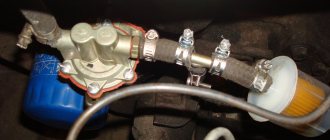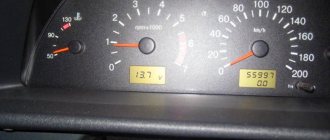Hi all! The issue of traffic rules has not been discussed for a long time. And then an unpleasant traffic situation arose, which prompted the idea to talk about the Narrowing of the road sign.
Many have seen it, but not everyone knows how to act correctly in a given situation. Moreover, we are talking specifically about a red triangular sign. There is also blue, which is often confused with narrowing. In fact, a similar blue sign means the end of the strip. If anyone is interested, we will discuss it in our separate article.
Today we focus on the signs of the 1.20 series. Let's try to find out how to pass on the left or right, who should give way and how to act if narrowing occurs on both sides.
What does the “Narrowing Road” sign look like and what does it mean?
This sign may look different. It all depends on what kind of narrowing of the road it is. The road narrowing can be:
- on right;
- left;
- at both sides.
Depending on the type of narrowing, a corresponding sign is installed to warn drivers that some of them, depending on their position on the road, will need to change lanes or give way to another car. This is necessary in order to maintain order on the road, so that drivers clearly know what to do and no dangerous emergency situations arise.
The narrowing itself can be temporary or permanent, depending on the situation. There are some areas where it was impossible, for one reason or another, to build an equally level road with a standard width. Therefore, such a sign is installed on a permanent basis in these areas. But, in most cases, such signs are installed temporarily on normal standard roads, for example, if repair work is underway there. Since it is not always possible to block all traffic on the road during repair work, only part of it is closed, one lane, and the other is left so that drivers can pass. And so that drivers know in advance that repair work is underway in this area and the road is narrowing, appropriate signs are installed. If the sign is temporary, it will be yellow.
In addition to installing a road sign “Narrowing of the road”, it is also necessary to install a sign notifying about road work. After the work is completed, both signs are removed.
In large cities, such signs are located in areas where there are public transport stops. The signs are there permanently so that buses, trolleybuses, minibuses and other types of public transport can stop, disembark and pick up new passengers without interference. And ordinary cars will not interfere with them at this moment.
Travel rules
By default, all 3 “Road Narrowing” signs warn the vehicle owner about particularly dangerous areas. Usually, if a narrowing is planned, then a reduction in the number of lanes is also planned, and this is directly related to the implementation of lane changes, when priority rules are of great importance.
The mentioned group of signs is classified as a warning type: they do not regulate the primacy of traffic, here everything depends on the situation and the level of theory of drivers when crossing controversial areas.
Who must give way to a narrowing on the right or left
Here the matter directly concerns the parallel flow of cars that follow in the same direction on a flat section of the highway. When the route narrows to the left, then the standard condition works correctly. But where the arrow shows that the right lane needs to be shortened, then it is necessary to refer to the fact that the left lane is moving without interference, so you will have to slow down and try to enter from the left only if there is free space. In the case of heavy traffic, this maneuver risks taking a lot of time and effort, and there is no rush here.
Although the opposite cases are stipulated: when there is a congestion of cars in the coverage area of the sign “Narrowing of the road on the right” due to the impossibility of changing into the left lane, drivers moving in the adjacent lane can let other people’s cars pass. Moreover, quantitative control is excluded here: everything is decided primarily on the basis of driver solidarity.
If you see that there is a traffic jam on both sides, you should slow down and let several drivers pass in turn. In fact, this does not mean that you need to drive along the disappearing lane all the way in order to hope for the understanding of your colleagues. It is much more logical to check in advance whether there is an opportunity to join another lane more actively.
Bilateral narrowing
Much more problems arise when passing the sign in question, warning that further down the road there is a planned narrowing on both sides. Here it is much more difficult to decide who is obliged to let pass, and who is only to claim the right of priority during travel.
If the road has 3 lanes, then everything is clear: a person moving along the central road has no obstacles. And vehicles traveling in assembly are obliged to join the middle row whenever possible, giving way to drivers driving on a straight road. When there are only 2 lanes and there is a smooth merging of rows, not adjoining, then the “right hand” principle is already in effect: the driver on the left must give way.
Separately, it is necessary to mention situations where a narrowing of the road surface occurs in the absence of the necessary sign on the path. This rarely happens, especially within the city, but on a suburban highway, traffic police officers sometimes forget to install this temporary sign. Then a “neck” appears, sometimes simultaneously with the absence of the marking itself.
Here one should rely on a related rule, as if the sign were in fact - the lane where the congestion initially occurred should be perceived as disappearing. But often the application of these rules is impracticable due to the large concentration of cars and it is difficult to understand which lane should disappear before the car reaches the congestion site.
Who should give in if contraction is ahead?
Situations when a driver has to deal with this sign are described earlier in the article. But here's what you need to do if there is a planned narrowing of the road ahead and it is unclear who is obliged to give way during future maneuvers - the neighboring traffic or you?
As the injured party, it is worth remembering that this is not the fault of the passing traffic, which follows in the same direction at a standard speed of 60 km/h, and even faster outside the city. Therefore, traffic regulations state that one way or another the owner of a vehicle is obliged to give way to passing traffic (nearby cars in an adjacent direction).
However, you don’t have to wait until all the cars have passed along the specified road. If a traffic jam develops from the lane ahead, then they are also required to let through from the adjacent passing lane, guided by the same traffic regulations (only not all at once, but one car at a time).
There is a driving ethic where other road users try not to tightly occupy the lane that touches the narrowing zone so that other road users can change lanes in time. Sometimes this is not possible (for example, at intersections), so it is necessary to plan lane changes in advance.
Who should give way when the road narrows?
The order of passage through disputed areas depends on the specific situation, knowledge of the rules and ethics of behavior in traffic flow.
The rules state that regardless of the type of narrowing, a driver moving along the lane in the direction of the sign must give way to a car in the lane without changing the nature of the area . That is, a car moving in a narrowing right or left lane must slow down and let passing traffic pass. If a traffic jam occurs, it is necessary to follow the rules of ethical driving and give the opportunity to steer cars in front of a narrowing section.
With two-way narrowing, the situation depends on the number of lanes of the roadway. The driver moving in the middle lane of a three-lane roadway has the right of way . On a two-lane road, if both drivers need to change lanes at the same time, then the car on the right has priority.
Violators of maneuvering rules are subject to an administrative penalty in the form of a warning or a fine of 500 rubles. (Article 12.14 of the Code of Administrative Offenses of the Russian Federation).
Knowledge of road signs and compliance with traffic rules will save motorists from material losses in the form of a fine, unpleasant explanations with inspectors and emergency situations.
Subscribe to our feeds on social networks such as Facebook, Vkontakte, Instagram, Pinterest, Yandex Zen, Twitter and Telegram: all the most interesting automotive events collected in one place.
In what cases can you encounter such a sign?
There may be several such situations. The most common reason in cities is public transport stops. They are not always marked with this sign; they usually make do with road markings. But there are other unobvious reasons that are difficult to predict on your own. For example, you are driving along a spacious avenue, but then you see a sign that the road will narrow after the intersection, and you are almost at the traffic light, it is almost impossible to change lanes, and after passing this place there will be no more time. In this case, you will have to stay a little longer and wait until they give way to you in the adjacent lane, since you are not in a dominant position, but you cannot move insolently towards the narrowing.
Varieties of sign
Here we are talking about signs 1.20, of which there are actually 3. And they have slightly different appearances, installed in appropriate situations. In the photo you can clearly see the difference.
The point of the sign is that two lanes merge into one. The only question is that there is an acceleration lane, and there is another narrowing lane. That is, they move straight along one, and perform a maneuver along the other. But there is an exception in the form of the third sign, where the maneuver is provided from two lanes at once, which begin to narrow. I think it is about this sign that the greatest number of disputes and conversations arise.
As for the signs themselves, they are presented in the form of a red triangle with a white background. The background can also be yellow, which means the sign is temporarily located in this area. They are installed during repair work.
When the repair is completed, the structure is removed and it ceases to function.
But the image inside the triangle comes in 3 types. Hence the division into subcategories of the sign.
- 1.20.1. Such an indicator is presented in the form of the same triangle, inside of which 2 black stripes narrow. From expansion begins contraction. This means that change occurs on both sides;
- 1.20.2. Here the left black stripe remains straight, and the right one is curved. I think it’s not difficult to understand that the narrowing occurs on the right side;
- 1.20.3. The situation is the opposite of the previous one. The left stripe is straight, and the right one tapers.
There are different signs on the roads. From them, the driver can understand in advance that there will be a narrowing ahead. Moreover, some motorists must change lanes or yield to other drivers, depending on where they are moving and in which lane.
This makes it possible to regulate the flow of cars on sections of roads that narrow.
The narrowing can be permanent or temporary. In the first case, the pointer will have a white background, and in the second, yellow.
Signs are located at a distance of 50 to 100 meters from the narrowing itself, if it is located within a populated area. Outside populated areas, according to the rules, the sign must be placed at least 150 and maximum 300 meters away.
There are also large cities where such signs are located specifically at public transport stops. According to traffic regulations, drivers do not have the right to enter there, since this is a designated area for public transport where passengers pick up and drop off. A smart solution for security purposes.
High efficiency
Experts confirm the opinion of data processing center specialists regarding the high efficiency of the new marking scheme.
— Re-marking with narrowing and adding traffic lanes allows, without expensive capital work, to maximize the efficiency of using road infrastructure, to equalize the capacity of road sections and the load on them. Additional lanes can be used in different ways: add forward lanes, organize new left turns and U-turns and thereby reduce overruns, return two-way traffic, introduce dedicated lanes for public transport without reducing the number of general lanes, and finally, organize new parking spaces, notes the member public council at MTDI of the Moscow region Andrey Mukhortikov.
According to Mukhortikov’s calculations, the capacity of re-marked areas increases by 15–30%, sometimes more. The impact on safety is also positive: in narrow lanes you don’t want to drive faster than 60–70 km/h, and waiting for a left turn in a separate pocket is much more convenient than in a general lane with straight traffic. The potential for re-marking roads in Moscow is far from being exhausted, the expert believes, so the process will continue for at least several more years.
Slenderness suits them
Photo: TASS/Vyacheslav Prokofiev
State Duma deputy Alexander Vasiliev agrees with him.
— Many people here refer to GOST, according to which it is necessary to make a 4-meter lane, but in fact they don’t look into it and don’t know that it can be narrowed even to 2.75 m. Therefore, with the correct organization of traffic, the lanes can be narrowed, adding bike lanes just requires the right skills and abilities. The Data Center, in my opinion, can and does do this. We need to look at every site and take into account people’s opinions. Sometimes, due to proper re-marking, even an additional parking space may appear,” Vasiliev noted.
Who should give way?
There may be more situations than the scope of one article will allow us to consider, but we will analyze the most frequent and basic ones - the rest can be easily deduced from these. What it looks like will be separately indicated in the pictures.
When changing lanes
Two cars are moving in the same direction. Rebuilding is underway. Who should skip whom? Is the one on the right always right? Let's remember clause 8.4 of the traffic rules, according to which:
- If both cars change lanes at the same time, the one on the right has the advantage.
The most important thing about rebuilding
So, first of all, let's find out the main facts about this maneuver. They include both related traffic rules responsibilities and simple rules that many motorists may not be aware of.
- When changing lanes, you are required to turn on the appropriate turn signal: in the left lane - left, in the right lane - right (clause 8.1 of the Rules).
- But the sign should not mislead other drivers. For example, if you are going to change lanes across 2 lanes at once, then you need to turn the turn signals on and off 2 times, since the 2022 legislation requires them to be turned off immediately upon completion of the maneuver, and changing 2 lanes means 2 consecutive maneuvers, not one whole.
- You can change lanes not only into the adjacent lane in the same direction, but also into the oncoming lane - this will in no way cancel the very fact of the presence of the maneuver of the same name.
Is it possible to challenge a fine?
Modern drivers are more educated than their colleagues 20-30 years ago, so they easily enter into disputes with representatives of law enforcement agencies responsible for enforcing traffic rules. We recommend doing this only in cases where you are absolutely sure that you are right. Situations with passing SD signs are interpreted quite unambiguously, so here your chances of avoiding punishment in the event of an obvious violation are minimal. The traffic police officer is not obliged to inform you that your violation was recorded by appropriate technical means, so you take a big risk by filing an appeal. We do not encourage you to negotiate on the spot, especially since this violation is subject to the law on a twofold reduction in the amount of the fine, provided it is paid within 10 days. In any case, the fine is not so large as to require an auto lawyer to get involved. Just try not to break the Rules in the future.
vote
Article rating











